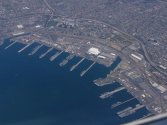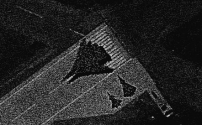Funding is an issue for the Russians. The Russian economy is the same size as 8 years ago since the Ukraine crisis of 2014. At the same time, Russian military spending increased to 5% and has only dropped down slightly to 4.3% currently.
Not true. Russian Federation GDP in PPP is higher than it was in 2014.
The notion the economy is the same as in 2014 is kind of ludicrous. Not when Russia has gone from a food importer to a food exporter.
Construction of civilian transport aircraft has also gone way up like you can tell with the Sukhoi Superjet aircraft program.
Military spending was cut slightly because the state's tax revenues went down with the oil price drop. But now oil is over twice the price back then.
And if we're talking about equivalence, we really need to compare the Su-57 to the combined stealth fighter fleets of the F-22/F-35 or even J-20/J-31. Russia's 10 year production plan only plans on a total of 78 Su-57. That's less that 8 per year on average.
Even back in the time of the Soviet Union the development of aircraft was out of step with the US. The Su-27 entered service in 1985.
The F-15 entered service in 1976. That is almost a decade. F-22 entered service in 2005, while the Su-57 entered service in 2020. Part of the benefit is those aircraft are at least half a generation ahead of contemporary US fighter designs. The Su-27 has relaxed stability, which the F-15 does not have, and the Su-57 has IRST, DIRCM, side radar, 3D TVC, and moveable surfaces, which the F-22 does not have.
The amount of Su-57 aircraft on order right now is a minimum level and the Russian government typically increases orders with time. A couple years ago Western reports were saying the Russian government only ordered like 12 aircraft and the program was clearly doomed. Now it is 78 aircraft. They simply do not understand Russian government procurement at all. It is not like the US where they plan for 500 aircraft then do progressive cuts and end with less than 200. They start with a small order, and increase it as the product is more mature and cost effective. If it isn't it gets redesigned and production is only ramped up after maturation and cost reduction. This happened with the Su-27 for example which had a long and tortuous development process.
That is continuing low-rate production and not actually a ramp up. For comparison, J-20s took approx 4 years to ramp up to 36-50 per year currently. The F-35 has even higher numbers.
These aircraft are in different parts of the production cycle. 50 aircraft per year for the J-20 is just an over the top estimate. At most it is 40 per year. The F-35 entered service almost seven years ago. The F-35 is a single engine aircraft and it has lots of orders outside the US. There is no comparison possible. Also, the Russian Federation spent capital on purchasing 103 Su-35 aircraft. Compare that with China which was still mostly operating the J-11B. The Su-35 was designed at a time when the F-22 program was already well known and it was clearly designed to be able to be competitive against it. There is much less of a pressing need to produce the Su-57 right now. This can be seen in the fact that not only did the Russians not stop Su-35 production, they still operate the same amount of production lines.
New Tu-160M2 airframes should be fairly inexpensive given that it's an existing airframe, particularly compared to a stealth bomber.
But let's see what happens with the PAK-DA.
No way. The Tu-160M2 is a quad engine variable geometry aircraft. It should be more expensive, not less expensive to produce than a flying wing. The Tu-160M2 was basically a reverse engineered Tu-160 aircraft. You should compare this with the H-6K vs H-6 aircraft. It might look the same externally but it isn't the same. They had to digitize all the documentation and build new production facilities for components like the large titanium forgings. Sure, they still had the aircraft assembly building, but all the other production facilities likely had to be rebuilt.
I reckon that an H-6 costs around $80Mn and that a B-21/H-20 equivalent would be at least 500Mn.
So 6 H-6s might cost the same as a single H-20.
But each individual H-6 has a comparable payload of 10-12tonnes and a useful range of 3000km from mainland China.
That is useful when you're talking about big antiship missiles or cruise missiles.
Maybe. It will also cut into the supply of engines for the fighters. They will need to vastly expand engine production.
I think it's a given that B-21 procurement numbers will be greater than that of B-2, since it would need to replace B-2 and B-1s. Based on what I can gather, USAF has 45 B-1Bs and 20 B-2s still in service along with 76 B-52s. That does not sound like a lot. The reality is that you don't need a lot of strategic bombers when they have combat radius of over 5000 km. A lot of their bomb truck roles will be taken over by strike aircraft like F-15E or UCAVs. As time goes on, the reality of procurement and maintenance cost for strategic bombers will limit their numbers. As such, I doubt B-21s will replace B-2/B-1B on a 1-to-1 basis over the next 20 years. I also doubt that B-21s will replace B-52s on a 1-to-1 basis. You simply don't need it and can't afford it. Similarly, China probably doesn't need that many H-20s. 50 H-20s can probably achieve all the strategic goals that China has.
Actually I think the number of bombers both countries, Russia and the US, have will increase. With the cancellation of the Treaty on Conventional Armed Forces in Europe and the repeal of several other weapons control treaties I expect the amount of strategic bomber platforms to increase slightly. As for China I don't know what they will do but they clearly have a large requirement and they currently have a large bomber force.
I'm pretty pessimistic about Russia's aerospace defense industry and resources. They were only able to buy 21 aircraft in all of 2021 (including fight jets, trainers, transport, everything). It's been that way for a couple of years now after they purchase 80 to 100 aircraft a year back in middle part of last decade. At this pace, they will have a hard time putting a full squadron of Su-57s into service before 2025. I seriously doubt they will have the resource to finish PAK-DA development in the foreseeable future.
We are on a different stage of the production cycle. Other than the Il-76-MD-90 none of the transport aircraft designs are mature enough for mass production. The Il-76-MD-90 line is still ramping up. The Il-112V and Il-276 still don't have engines. The Yak-130 trainer used to rely on Ukrainian jet engine imports and only a couple years back did they manage to fully replicate an independent manufacture chain. The Su-34 is undergoing the upgrade program for the Su-34M for which the prototype still hasn't flown. The Su-57 is still ramping up and they are working on the Su-57M already. The Su-30SM2 only was introduced into service recently but there is a reduced need for these aircraft so few will be produced from scratch and most will be upgrades. As the Su-57 matures its production will ramp up. If they felt an immediate need for it they would ramp up production but the stated intention of the Russian Armed Forces staff is to put the Su-57M into service sooner rather than later.
For H-20, a fleet of 50 H-20s might allow 20 of them to be available at any given time (if we go by the heavy maintenance cycle that one would expect for such an advanced aircraft). That may not sound like a lot, but it would be sufficient to rotate through a conflict and take out pretty much any military base in surrounding area. You really only need to maintain 2 or 3 H-20s in the air and bombing target military base. How else would be able to do that outside of USAF?
I expect China to produce way more stealth heavy bomber aircraft than that. At least twice this amount.
The design has potential not just for bombing missions but also for long range sea lane interdiction and the like.
I was taking a look at maps this morning to just understand the strategic impact of H-20s. I don't think I need to rehash its ability to take out military installations in Northern India/Japan/Guam/Okinawa, but it's impact goes further than that. By placing H-20 takeoff point at Spratley island, it would be able to attack major Australian naval bases and put the north coast ones out of service for large part of a conflict. That would be huge in a battle.
The H-20 would be useful for control of most of the Pacific and the Central Asia area.
As for the other talk, about attacking the US mainland itself, I think that would require some other sort of aircraft. Something like a hypersonic bomber or a suborbital spaceplane. This is something China will have to design which neither Russia nor the US needs. Russia can attack all the US easily ever since they got the Tu-160 via a polar route. The US has bases all over the place. The only other alternative China has is to make their own bases. But this would be against Chinese policy. So I suspect the suborbital bomber or whatever is more likely and China is clearly developing the technologies to enable something like that.


